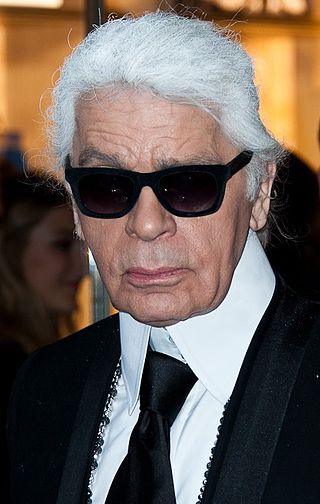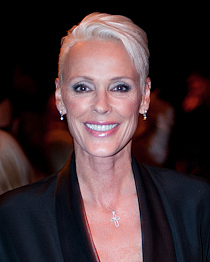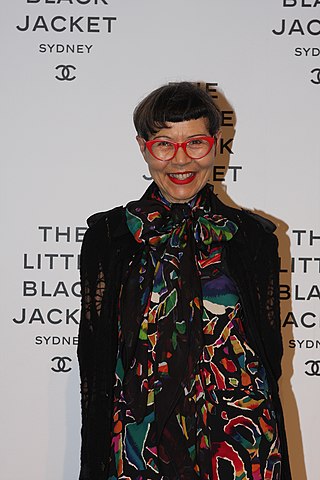
Karl Otto Lagerfeld was a German fashion designer, photographer, and creative director.

Dame Barbara Mary Quant was a British fashion designer and icon. She became an instrumental figure in the 1960s London-based Mod and youth fashion movements, and played a prominent role in London's Swinging Sixties culture. She was one of the designers who took credit for the miniskirt and hotpants. Ernestine Carter wrote: "It is given to a fortunate few to be born at the right time, in the right place, with the right talents. In recent fashion there are three: Chanel, Dior, and Mary Quant."

Brigitte Nielsen is a Danish actress, model, and singer. She began her career modelling for Greg Gorman and Helmut Newton. She subsequently acted in the 1985 films Red Sonja and Rocky IV, later returning to the Rocky series in Creed II (2018). Nielsen starred in the 1986 film Cobra alongside her then-husband Sylvester Stallone. She played a villain in Beverly Hills Cop II (1987) and starred as the Black Witch in the 1990s Italian film series Fantaghirò. She later built a career starring in B-movies, hosting TV shows, and appearing on reality shows.
Zuzana Licko is a Slovak-born American type designer and visual artist known for co-founding Emigre Fonts, a digital type foundry in Berkeley, CA. She has designed and produced numerous digital typefaces including the popular Mrs Eaves, Modula, Filosofia, and Matrix. As a corresponding interest she also creates ceramic sculptures and jacquard weavings.
Project Runway is an American reality television series that premiered on Bravo on December 1, 2004. The series focuses on fashion design. It was created by Eli Holzman and was hosted by Heidi Klum from 2004 to 2017. It has a varied airing history, with Bravo originating the first five seasons, followed by Lifetime for eleven more. The show has had over 30 international adaptations.

Dame Zandra Lindsey Rhodes, is an English fashion and textile designer. Her early education in fashion set the foundation for a career in the industry creating textile prints. Rhodes has designed garments for Diana, Princess of Wales and numerous celebrities such as rock stars Freddie Mercury and Marc Bolan. She has also designed textiles for interiors, featuring her prints on furniture and homewares. In 2003 Rhodes founded the Fashion and Textile Museum in London.

Kris Holmes is an American typeface designer, calligrapher, type design educator and animator. She, with Charles Bigelow, is the co-creator of the Lucida and Wingdings font families, among many other typeface designs. She is President and Co-Founder of Bigelow & Holmes Inc., a typeface design studio.

Anni Albers was a German-Jewish visual artist and printmaker. A leading textile artist of the 20th century, she is credited with blurring the lines between traditional craft and art. Born in Berlin in 1899, Fleischmann initially studied under impressionist painter Martin Brandenburg from 1916 to 1919 and briefly attended the Kunstgewerbeschule in Hamburg in 1919. She later enrolled at the Bauhaus, an avant-garde art and architecture school founded by Walter Gropius in Weimar in 1922, where she began exploring weaving after facing restrictions in other disciplines due to gender biases at the institution.

Vuokko Hillevi Lilian Eskolin-Nurmesniemi is a Finnish textile designer. She is best known for her work as one of the two leading designers of the Marimekko company. Her signature striped Jokapoika shirt helped to make the company's name.
Maud Frizon de Marco is a fashion designer specializing in women's shoes. She began her career in the 1960s as a model for Parisian Haute Couture Houses of Nina Ricci, Jean Patou, and André Courrèges. At the time models had to provide their own shoes to match the clothes designers assigned them for their runway shows and photo shoots. Frizon disliked the available shoes from other designers, and in 1969 elected to create her own and opened her first boutique in the Saint-Germain-des-Prés district of Paris.

Nadja Tiller was an Austrian actress in film, television, and on stage. She was one of the most popular German-speaking actresses in the international cinema of the 1950s and 1960s, receiving international recognition when she played the title role in the 1958 film Das Mädchen Rosemarie (Rosemary) in 1958, shown at the Venice Film Festival. It opened the way to international films. She often played alongside her husband, Walter Giller.

Antonia Garrn is a German model. She rose to prominence in the fashion industry after signing an exclusive contract with Calvin Klein in 2008. She is married to British actor Alex Pettyfer, with whom she has a daughter.

Jenny Margaret Kee, is an Australian fashion designer.

Mikiko Ponczeck is a German-Japanese comic book and manga artist.

Brigitte Kronauer was a German writer who lived in Hamburg. Her novels, written in the tradition of Jean Paul with artful writing and an ironic undertone, were awarded several prizes, including in 2005 the Georg Büchner Prize, in 2011 the Jean-Paul-Preis and in 2017 the Thomas Mann Prize.

Germany plays an important role in the fashion industry, along with France, the United Kingdom, the United States, Italy, Spain, and Japan. German fashion is known for unconventional young designers and manufacturers of sports and outdoor clothing, ready-to-wear and custom-made creations.

Ilonka Karasz, was a Hungarian-American designer, interior decorator, painter and illustrator known for avant-garde industrial design and for her many New Yorker magazine covers.
Lillian Grace Delevoryas was an American artist whose career spanned six decades. Trained in Fine Art, Calligraphy and Woodblock printing she initially achieved recognition during the 1970s for her pioneering work in appliqué and tapestry for the fashion and interior design industries. In the 1980s this recognition led to commissions for commercial applications over a range of consumer products, most notably pottery, textile and paper. Since the 1990s, Delevoryas returned to painting and continued to exhibit and promote her work. She lived in the UK since the early 1970s and was married to the writer and poet Robin Amis.

The fashion industry in Nigeria plays an important cultural role and contributes significantly to the country's economy. Clothing incorporates a variety of colours, fabrics, and embellishments. Many of the component cultures of Nigeria wear styles that are characteristic of their tribal society and customs. Nigeria produces fashionable textiles and finished garments and has designers who have achieved international recognition.















